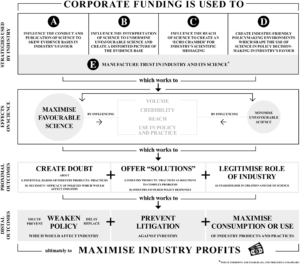How do corporations work to influence science, and why? A new paper from University of Bath researchers Tess Legg, Jenny Hatchard and Anna Gilmore synthesises previous literature to show how eight industries use similar strategies to influence science in their favour.
The Covid pandemic has brought science and scientists to the forefront of public attention. And public trust in science – science which informs unprecedented policies that protect public health - has never been so essential. To be “guided by the science” means that the public, academics, health professionals, policy-makers, and the media must have confidence that scientific research has been conducted with integrity.
Influencing science
Science, and the messages drawn from it, can be manipulated by vested interests. And major industries have used science to delay progress in tackling threats to human and planetary health. This new study from the University of Bath brings together, for the first time, literature on eight corporate sectors to understand how they use science to weaken policy, prevent litigation, and promote industry products and practices to maximise corporate profitability.
The Science for Profit Model
The research identified five major strategies (broken down into 64 finer-detail strategies) used by eight industries (alcohol; chemicals and manufacturing; extractive; food and drink; fossil fuels; gambling; pharmaceuticals and medical technologies; and tobacco).
1. Influence how science is conducted and published to skew evidence in industry’s favour
To counter scientific research which might cast their products and practices in an unfavourable light, companies use various strategies to influence which research is and isn’t undertaken and published. These include funding ‘safe’ research to deflect attention from industry harms, such as the alcohol and gambling industries funding research on the ‘problem drinker’ and ‘problem gambler’, thereby framing corporate harm as an individual issue. Other strategies include using inappropriate study design or statistical analyses to ensure favourable findings, and cherry-picking which papers to include in literature reviews to obscure parts of the evidence base.
2. Influence how science is interpreted to undermine unfavourable science and create a distorted picture of the evidence base
Strategies in this category are used collectively to distort how science and scientists are seen by the public and experts. Some corporations obtain and re-analyse raw data to undermine it, while others publicly attack research papers and researchers to provoke public doubt and mistrust. For example, independent scientists reporting the harms from second-hand smoke, fossil fuels emissions, plastics, lead, and pharmaceuticals have been subject to attacks on their science and their professional reputations.
3. Influence the reach of science to create an “echo chamber” for industry’s scientific messaging
Industry seeks to promote its own favourable science by disseminating and amplifying messages which support its scientific stance, whilst hiding unfavourable evidence. A common approach is to contract “friendly” voices to amplify scientific messages and distance these messages from industry. These messengers include front groups, designed to look like unbiased sources (such as those created by sugary drinks corporations to promote their preferred messages on sugar), third-party organisations such as think tanks and professional associations, “expert” individuals, and allied industries.
4. Create industry-friendly policymaking environments which shape the use of science in its favour
Evidence shows that as well as promoting pro-industry science, companies also seek to influence policy-making. British American Tobacco, for example (along with the chemicals and fossil fuels industries) promoted a set of regulatory reforms in the EU, now known as “Better Regulation” or “Smart Regulation”, to control how science is used in policy-making. They hoped the reforms would make it harder to pass public health policies which countered their interests.
5. Manufacture trust in industry and its scientific messaging
Corporations seek to manufacture trust in themselves and their science, for example by funding academics, students and universities. The alcohol, sugar and fossil fuels industries have spent large amounts of money courting academics, thereby normalising their involvement in science and research. Conversely, at times industries hide their involvement if they believe it might cause readers to distrust their science, often using public relations and law firms to enable this.
The Science for Profit Model

Together, these strategies maximise the volume, credibility, reach and use of science favourable to industry, and minimise those same aspects of unfavourable science. This enables industry to create doubt about the harms of their products or practices, or about the necessity of policies that would affect them. It also offers industry ‘solutions’ (those involving industry products, or pro-industry policy responses), and legitimises industry’s role as a stakeholder in the creation and use of science.
This new research shows that corporate influence on science is not limited to a few outliers. The same strategies were identified time and again across eight major corporate sectors; strategies which involve industries permeating and moulding scientific, academic, and policy-making systems to ensure such systems work in their interest.
Solutions
But the fact that this corporate influence occurs in similar ways and for similar reasons across diverse industries suggests that it should be possible to find collective solutions.
Ultimately the answer to minimising this corporate influence is to change the way science is funded (which in turn would help to address the strategies identified in this research). In Italy, California and Thailand, for example, levies on the pharmaceutical, tobacco, and alcohol industries have been used to fund independent research on their products. Such an approach likely represents the most effective and sustainable solution.
We discuss tobacco industry influence on science in our podcast Deadly Industry: Challenging Big Tobacco - listen here.



